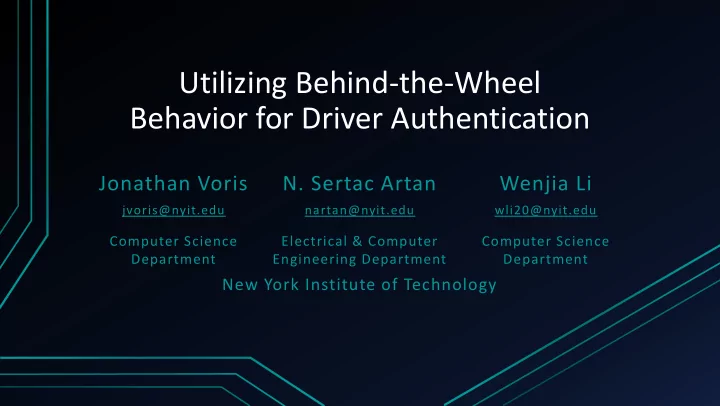

Utilizing Behind-the-Wheel Behavior for Driver Authentication Jonathan Voris N. Sertac Artan Wenjia Li jvoris@nyit.edu nartan@nyit.edu wli20@nyit.edu Computer Science Electrical & Computer Computer Science Department Engineering Department Department New York Institute of Technology
Driver Data Collection • Amount of driver data being recorded is increasing • Many new devices and applications 2
Sensing Application: Driver Authentication • Vehicles can verify driver identity by measuring distinctive characteristics • Potential applications to transportation security and safety 3
Potential Privacy Issues • Devices may record a variety of sensitive information including: • Geolocation • Audio • Images • Instantaneous engine readings 4
Potential Security Issues • Modern cars controlled by Electronic Control Units (ECUs) connected by a Controller Area Network (CAN bus) Sensors and communication interfaces available on a modern vehicle. Examples of CAN Connections [1] 5
Potential Security Issues • Devices connect to a vehicle’s CAN bus via an on-board diagnostics (OBD)-II port • Increases attack surface of critical components • Many devices also feature a wireless uplink 6
Threat Model • Situations where token based authentication could be bypassed: • A single-owner vehicle is stolen • A vehicle is driven by an uninsured driver • An unlicensed driver operates a taxi or limo • A car sharing service is used by someone who isn’t a member • Adversary with no special knowledge of individual’s driving behavior • Possibility of mid-session attacks • Carjacking 7
Driving Data Dilemma • Research challenge: how to enable emerging driving applications such as driver identification while ensuring • Driver privacy • Vehicular security 8
Solution Idea: Behind-the-Wheel Behavior Modeling • Decouple sensing from critical vehicle systems • Measure involuntary driving habits to discern driver identity • Potential modalities: • Steering behavior • Speed control characteristics • Indicator usage • Contextual road features 9
Related Work • Authentication via behavioral biometrics in other domains • Desktops and laptops • OS interactions [Payne ‘13] • File system usage [Ben Salem ‘14][Voris ‘15] • Stylometry [Stolerman ‘14] • Mobile devices • Touchscreen dynamics [Xu ‘14][Scindia ‘16] • Application usage [Voris ‘16] • Device movement [Sitova ‘15] 10
Related Work • Use of driving characteristics to categorize drivers by: • Level of drowsiness [Hartley ‘00] • Degree of aggressiveness [Jensen ‘11] • Issues with prior driver identification work: • Require intrusive sensors such as EEG [ Nakanishi ‘11] or dashboard cameras [Ji ‘04] • Privacy issues with some sensors such as geolocation [Tang ‘08] • May require access via a OBD-II board, exposing vehicle control network to attack [Salemi ‘15] 11
Advantages of Behind-the-Wheel Behavior Modeling • Driver identity verification would eliminate fraud • Deviations from past driving patterns can detect safety issues • Would not require direct access to a vehicle’s CAN bus 12
Preliminary Evaluation • Developed a simulated driving task on a desktop computer using the OpenDS driving simulator and a Logitech G27 Steering Wheel 13
Preliminary Study Design • Recruited 10 test subjects from university students and staff • Completed 4 laps each with a 5 minute duration • Collected raw data at 40 ms interval • Coordinates within simulation • Steering wheel position • Pedal positions 14
Feature Extraction • Grouped raw data into 10 second samples to extract features: • Euclidean distance traveled • Average vehicle speed • Standard deviation of steering position • Average change of brake pedal position • Average change of gas pedal position 15
Multiclass Modeling • Applied several machine learning techniques to driving features • Decision Tree • With Boosting: Random Forest • Support Vector Machine • k-Nearest Neighbor • With Boosting: Random Subspace • Data labeled by driver for training and model verification • Plotted the true positive classification rate against the false positive classification rate to obtain a Receiver Operator Characteristic (ROC) Curve • Measuring the area covered by an ROC curve provides the Area Under the Curve (AUC) • Plotted the false negative classification rate against the false positive classification rate to obtain a Detective Error Tradeoff (DET) Curve 16
Multiclass Modeling Results ROC Curves for Multi-Class SVM Average DET Curve for Multi-Class SVM Classification. Classification of All Study Participants 17
Multiclass Modeling Comparison Comparison of AUC Values for Multiclass Modeling Techniques 18
Feature Analysis • Good behavioral modeling features should be: • Highly consistent for any given driver • Highly distinct between any given drivers • Can be measured using Fisher’s separation function: 19
Feature Analysis Results • Compared extracted and raw features Fisher Scores for Driving Features 20
One-Class Modeling • Multiclass modeling performed for algorithm comparison • Requires all user’s data for training • One-Class training more appropriate to driver modeling • More scalable to busy driving environments • Other driver’s data might not be available 21
One-Class Modeling Results ROC Curves for One-Class SVM Average DET Curve for One-Class SVM Classification Classification of All Study Participants 22
Time To Detection • How long to detect an unauthorized driver? • Modeling sampling rate of 10 seconds • Set acceptable false positive rate to one per 46-minute driving day • Requires a maximum per-sample FP rate of 0.362% • At this FP, TP rate is 19.5%, or 80.5% chance to evade detection per sample • Samples required for 95% detection confidence: 14 23
Time To Detection • Samples required for 95% detection confidence: 14 • Average time to detection: 2 minutes and 20 seconds 24
Conclusion • Novel applications such as driver authentication offer benefits to transportation systems • Authenticating drivers by modeling their behind-the-wheel behavior seems like a promising approach • Prevents token theft and relay attacks • Can be performed throughout a session • Care must be taken to do so in an unobtrusive and privacy-conscious fashion • Future work: • More comprehensive study with broader population currently underway • Analysis additional modeling features and algorithms • Susceptibility of behavioral driver authentication to attack 25
Thank you! 26
Recommend
More recommend